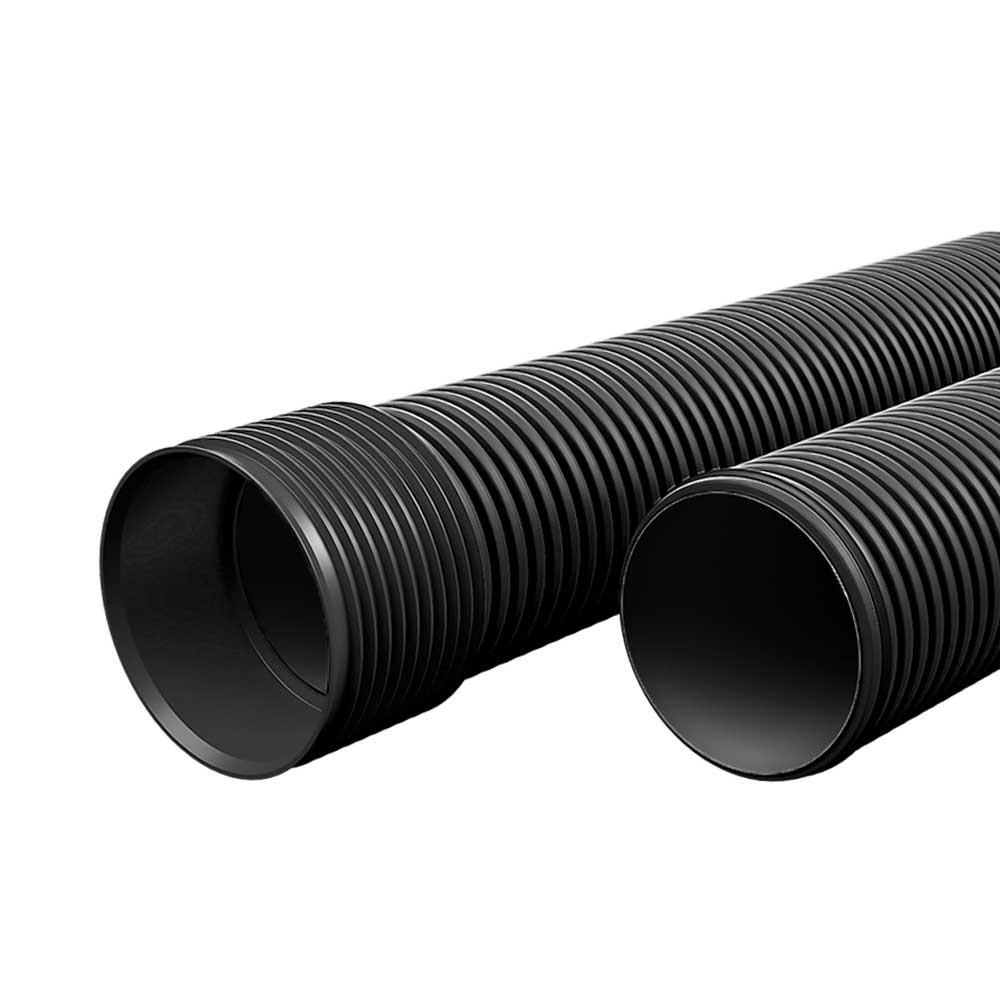Products / Stormwater Pipe & Fittings / EnviroStorm® HDPE SN8 Pipes / EnviroStorm Perforated (Slotted) Corrugated HDPE Pipe
EnviroStorm perforated (slotted) HDPE for infiltration trenches, edge drains and groundwater control — smooth-bore, durable and low-maintenance.
EnviroStorm perforated HDPE pipe is a corrugated PE system with factory slots for both sub-soil drainage and infiltration of stormwater runoff—helping prevent groundwater issues and restoring soil recharge on urban sites. In fine sand and coarse silt, specify a filter sock to stop fines entering the slots and to stabilise soil around the corrugations. Slotted and un-slotted coil are manufactured in accordance with AS 2439. Pipes are rubber-ring jointed and each pipe is supplied with an EPDM seal.
In simple terms: a tough, lightweight slotted plastic pipe that lets water in and moves it on—made for drains and infiltration trenches.
| Manufacture / standard | Slotted & un-slotted coil to AS 2439. |
| Jointing | Rubber-ring (EPDM) push-fit; each pipe supplied with a seal. |
| Filter sock | Thermal-bonded geotextile sock available; prevents fines entering slots and stabilises soil around corrugations. |
| Material properties | High crush resistance; chemical & corrosion resistance; UV-resistant; micro-organism resistant; low roughness; abrasion-resistant. |
| Slotting availability | Perforated sizes differ from the solid range: DN225–DN900 as listed; DN100 & DN150 are supplied as sub-soil coil (Agi) only. |
| Pipe DN (mm) | Inlet Area (mm²/m) |
|---|---|
| 225 | 1527 |
| 300 | 1357 |
| 375 | 1357 |
| 450 | 2827 |
| 525 | 1885 |
| 600 | 2356 |
| 750 | 2827 |
| 900 | 2356 |
DN100 and DN150 are for sub-soil drainage only (Agi coil).
| Product Code | DN | Outside Diameter (mm) | Internal Diameter (mm) | Nominal Overall Length (mm) WA | Length (SP/SQ) Effective Length (mm) WA | Nominal Overall Length (mm) QLD & VIC | Length (SP/SQ) Effective Length (mm) QLD & VIC | Stiffness Class (SN) | Inlet Area (mm²/m) | Jointing Method |
|---|---|---|---|---|---|---|---|---|---|---|
| ENVIRO225SL | 225 | 257 | 223 | 6070 | 5950 | 6340 | 6200 | 8 | 1527 | Rubber Ring |
| ENVIRO300SL | 300 | 339 | 294 | 6060 | 5915 | 6340 | 6165 | 8 | 1357 | Rubber Ring |
| ENVIRO375SL | 375 | 425 | 371 | 6020 | 5840 | 6280 | 6060 | 8 | 1357 | Rubber Ring |
| ENVIRO450SL | 450 | 508 | 438 | 6030 | 5830 | 6300 | 6065 | 8 | 2827 | Rubber Ring |
| ENVIRO525SL | 525 | 595 | 514 | 6000 | 5735 | 6240 | 5970 | 8 | 1885 | Rubber Ring |
| ENVIRO600SL | 600 | 672 | 591 | 6040 | 5750 | 6140 | 5815 | 8 | 2356 | Rubber Ring |
| ENVIRO750SL | 750 | 835 | 731 | 6050 | 5750 | 6180 | 5820 | 8 | 2827 | Rubber Ring |
| ENVIRO900SL | 900 | 995 | 869 | 6040 | 5750 | 6260 | 5900 | 8 | 2356 | Rubber Ring |
Note: DN100 & DN150 are supplied as agricultural drainage coil (Agi pipe) to AS 2439 with optional filter sock — not included in the perforated ring-jointed EnviroStorm range above. Inlet area values shown apply to the perforated sizes listed.
Sub-soil drainage and infiltration trenches to manage groundwater and recharge soils — e.g. edge drains on roads, retaining walls, sports fields, golf courses, parks and gardens, and mining/industrial leachate control.
DN100 & DN150 (sub-soil coils), plus DN225–DN900 perforated straight lengths. Other sizes can be project-produced on request.
Yes — DN100 & DN150 are supplied as coils (with optional filter sock). DN225–DN900 are supplied as 6 m ring-jointed lengths.
PE100 high-density polyethylene — UV-stabilised (carbon black), chemically resistant, corrosion resistant, and not a nutrient medium for micro-organisms.
Slotted and un-slotted coils are manufactured to AS 2439. Ring-jointed straight lengths use EPDM rubber seals. Always confirm project/authority requirements with your engineer.
Push-fit EPDM rubber ring joints. Clean, lubricate, orient the ring correctly, and push to full engagement.
In fine sands and coarse silts to prevent fines entering the slots and to stabilise the soil around corrugations. Available thermal-bonded, fitted to coil or supplied separately.
Representative inlet area (mm²/m): DN100 1500; DN150 1500; DN225 1527; DN300 1357; DN375 1357; DN450 2827; DN525 1885; DN600 2356; DN750 2827; DN900 2356. DN100 & DN150 are for sub-soil drainage only.
Yes. For DN225–900, cut at the centre of a valley only and seal the airways before jointing. Install the EPDM ring in the last valley, aligned with the airway. (Contact us for cutting guidance on other sizes.)
Yes — black HDPE with carbon-black stabiliser is suitable for outdoor exposure during storage and installation.
Designed for a long service life under normal buried, gravity-drainage conditions. Actual design life depends on site conditions, loading and specification.
By truck. Customer to unload via forklift as standard. Crane truck can be organised on request.
Yes — couplings, junctions, reducers and end caps to suit; filter socks (fitted or loose) and approved lubricants.
DN and quantity, any authority or project specs, delivery window and site access.
